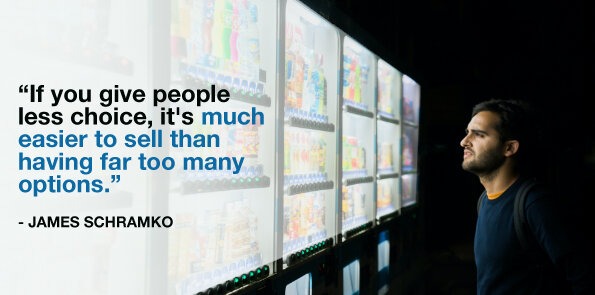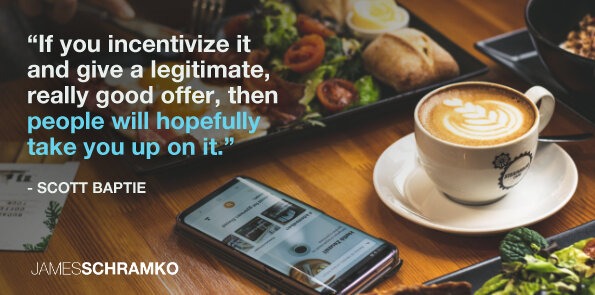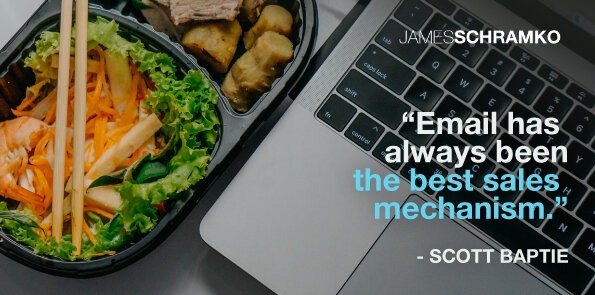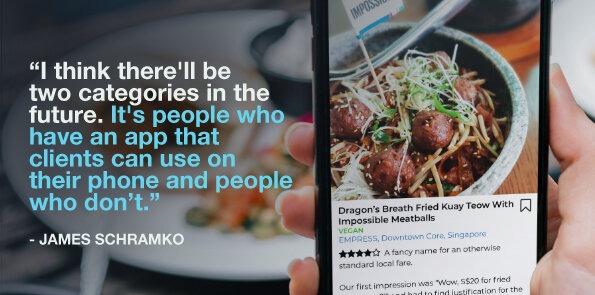Podcast: Download (Duration: 39:11 — 36.6MB)
Get Notified Of Future Episodes Apple Podcasts | Spotify | Amazon Music | Android | Blubrry | Gaana | TuneIn | Deezer | Anghami | RSS | More
The last time Scott Baptie guested on the show, it was 2015, and Scott was a fitness expert discussing the intersection of health and business, especially in terms of the food we eat.
Scott is still into health and nutrition, only his focus and methods have changed. From focusing on weight loss and performance athletes, he now uses recipes and an app to reach a much broader audience via recurring subscription.
This shift aims to educate people on using quality ingredients to create wholesome meals, countering the current trend of unhealthy, processed foods and quick fixes.
Scott and James will be going into the why’s of his transition.
They’ll break down what Scott’s done right with the recurring subscription model.
And they’ll look at the possibilities that an app offers people with content and an audience.
Table of contents:
1. Scott’s content delivery five years ago
2. The matter of pricing
3. What prompted a new business model
4. Choosing a price and launch strategy
5. What the numbers say
6. What work goes into the product?
7. The excitement of recurring income
8. Earning well and sleeping well
9. Getting the word out there
10. Bringing people into the app
11. The shift to being mainly a creator
12. How Scott gets paid
13. Choosing an app, and other tech details
14. Who might consider getting an app?
15. Food, business and YouTube
Scott’s content delivery five years ago
Five years ago, the focus of Scott’s content delivery was on one-on-one meal planning and group coaching for weight loss, muscle building, and sports performance. He attempted a membership group for weight loss, inspired by his involvement in James’s community, but it failed to flourish due to pricing and other issues.
The popularity of the recipes in Scott’s plans led to the creation of ‘The High Protein Handbook,’ a digital recipe book with detailed nutritional information and unique barcodes for easy tracking in food apps, an uncommon feature but highly beneficial for users.
The matter of pricing
Scott speaks of the challenges he faced with pricing his weight loss membership, noting that a higher price point and the lack of a defined end date made it difficult to attract subscribers. He acknowledges that while some memberships thrive in this space, his own initial approach at 29 pounds may have been too steep compared to competitors priced around 15 pounds.
James reflects on the difficulty of selling memberships in a competitive market. The successes are often personalized, high-ticket programs that offer a clear time frame and dedicated attention. And while high prices can succeed in niche markets, Scott’s offering was a high-priced option in a market that typically favors lower-priced memberships.
James mentions a recent episode with Jarrod Robinson, where they spoke of achieving recurring income through a low-effort, low-cost model, banking on volume to make it profitable. The same episode focused on converting existing content into profitable material via an app.
What prompted a new business model
There’s been a shift in business models, says James, from traditional content delivery to app-based platforms, with Scott being a prime example of this transition.
Scott goes over the reasons for his business pivot. His series of digital recipe books, for one, was causing choice paralysis among customers. Additionally, the release of a professionally published book made his PDFs seem substandard, and interactions with industry friends highlighted the benefits of app-based content delivery.
Scott was convinced that consolidating his offerings into an app would modernize his content and provide a user-friendly experience. He partnered with Jarrod Robinson and The App Match to develop an app, which operates on a subscription model, offering a vast collection of recipes with easy search and filter functions.
The launch of Scott’s app, Food For Fitness, exceeded his expectations, garnering enthusiastic five-star reviews. Customers appreciated the convenience and quality of the app, confirming Scott’s belief that this was the right direction for his business.
Choosing a price and launch strategy
Scott devised his pricing and launch strategy for the Food For Fitness app by observing competitor pricing, and opting for a low-ticket entry point. The app was designed to be free to download with 50 recipes available, enticing users with visible but locked content, encouraging them to purchase a full subscription for additional access.
The subscription was priced competitively at £3.99 monthly or an annual rate, with a special launch offer for the yearly subscription.
The launch was highly successful, attracting 3200 subscribers in the first week, the majority of whom went for the annual subscription, due to the enticing launch price. Scott’s strategy of providing a substantial one-time offer proved effective in securing a significant number of long-term users.
What the numbers say
Scott’s successful launch put his business into immediate profit, with the expectation of a significant revenue boost every September on its launch anniversary, due to renewals.
With a low churn rate of just two percent and continued growth post-launch, Scott’s app is gaining more subscribers. He aims to retain them by providing fresh content regularly, with monthly themed recipe packs that ensure subscribers always have something new to look forward to.
James suggests that, based on the current churn rate, Scott could expect a high renewal rate, potentially exceeding 65% annually. This indicates the value subscribers find in the new content, and demonstrates the app’s success in maintaining customer interest and satisfaction.
What work goes into the product?
Scott details the daily work that goes into the product, part of which is cooking new recipes almost every day, despite his family’s occasional desire for simpler meals. He also reveals he has set up a fake kitchen in his office for filming YouTube videos, which serve as promotional content for the new recipes featured in the app each month.
To increase the app’s visibility and attract more subscribers, Scott has been actively working on YouTube. He films one of the five new recipes each month and uses it as a teaser to drive viewers to the app for the full recipe pack.
The YouTube channel, under Scott Baptie’s name and branded as Food For Fitness, benefits from Google’s search algorithm, which favors his content, a significant advantage over platforms like Facebook. This strategic use of YouTube contributes to the app’s growth and customer acquisition.
YouTube, James says, is also valuable as a long-term traffic generator, where successful videos can provide ongoing visibility and lead to a steady conversion of viewers into app subscribers, effectively generating more income and offering scalability for Scott’s business.
The excitement of recurring income
Scott is properly excited about the stability and growth potential provided by the recurring income from his app. He appreciates the predictability in revenue, which allows for better planning and offers a psychological relief compared to the uncertainties of launching new products and services.
Scott is also encouraged by the promising launch numbers, which were much better than he expected. He looks forward to seeing how the membership will grow over the next year, with the success of the app providing a solid foundation to build on while he continues to manage other revenue streams.
Earning well and sleeping well
James notices Scott is wearing an Oura ring. It’s had huge benefits, says Scott, phenomenal for sleep tracking.
James shows his ring, and shares his 92% sleep score. Scott has never had a sleep score in the 90s.
James credits the peace of mind that comes with recurring income. It’s like compound interest, he says, for its transformative effect on financial stability. He’s had recurring income since he quit his job in 2008, and he believes it absolutely has helped him sleep better.
Paired with an app via the Kleq platform, James’s membership has done even better, especially in terms of retention. So anyone with a product or service succeeding in other modalities would do well to consider making it accessible via an app.
Getting the word out there
For telling people about his app, Scott employed the Jeff Walker launch strategy, teasing the launch a month and a half in advance and engaging potential users with a survey to foster a sense of involvement in the app’s development.
The pre-launch phase included strategic email communications and content sharing to build anticipation.
For the actual launch, Scott released videos of new recipes and emphasized the benefits and limited-time offer of the app. His marketing efforts spanned across email, organic social media, and Facebook ads, with a focus on demonstrating the app’s features and usability.
Scott emphasizes the continued importance of email as the most effective sales tool, despite the emergence of new trends and technologies. He aligns with James on the effectiveness of email, YouTube, and apps in creating a solid foundation for acquiring and communicating with clients.
Bringing people into the app
James predicts a future where businesses are divided into those with an app and those without. He advocates for the former, as it simplifies customer access to products and services.
Scott has streamlined his strategy to direct potential customers to his app, removing the option to purchase individual PDFs and instead promoting his app or physical book.
Scott has reduced friction in the customer journey by replacing lead magnets and multiple steps with a straightforward invitation to download the app, providing immediate value with 50 free recipes. This approach not only simplifies the user experience but also showcases the full range of content available behind the subscription gate.
Scott leverages emails and YouTube content to guide users towards the app download. He notes, too, that the app is receiving the highest feedback of any product he’s released, stressing the benefits of subscription revenue and customer satisfaction.
The shift to being mainly a creator
Scott has transitioned into being primarily a creator, focusing on developing and filming recipes for his upcoming recipe book and YouTube channel. His current state of “manic mode” underscores the busy nature of content creation, especially with a deadline for his book submission looming.
Embracing James’s approach, Scott has built a team to handle operational tasks, allowing him more time to concentrate on the creative aspects of his work. This shift not only increases his productivity but also aligns with his goal to remain a relevant and active content creator in the long term.
How Scott gets paid
The payment collection process has been greatly simplified for Scott by the Apple and Google platforms, which handle transactions, disputes, refunds, and VAT issues on his behalf. Despite the fee of 15% for revenues under a million, Scott finds the convenience and trust associated with these platforms valuable, emphasizing their frictionless payment system that deposits earnings directly into his account.
The advantages of the system extend to currency conversion and trust, as customers can pay with a simple tap and see prices in their local currency. James agrees that the benefits of the process far outweigh the percentage lost to platform fees, especially when considering the complexities of international sales and currency conversions.
Choosing an app, and other tech details
The fear of extensive costs and complicated tech delayed Scott’s decision to get an app. Learning about more cost-effective, template-based platforms, however, convinced him to give it a go.
After speaking with Jarrod, Scott chose a platform that allowed for an easy, drag-and-drop style of app creation, similar to ClickFunnels but for apps. This option offered simplicity and a much lower cost, despite some limitations in custom feature development.
James points out that while customers often request additional features, not all are feasible or necessary; the key is to focus on what benefits the majority. He stresses that starting with a simple, cost-effective app can build the foundation and momentum needed before possibly investing in more sophisticated custom development later on.
Scott appreciates the straightforwardness and user-friendliness of the template-based app approach, emphasizing the simplicity of the user interface. This ease of use is crucial for engaging and retaining app users, demonstrating that sometimes less is more when it comes to tech complexity.
Who might consider getting an app?
Many hesitate to develop an app, believing they lack sufficient content or can’t compete with market leaders, but the goal isn’t to compete; it’s to enhance the brand and improve the experience for existing customers. The key is not the volume of content but repackaging and presenting it in a way that adds value to the customer’s experience.
James is of the view that apps are ideal for those with an established audience and existing products or services, providing a platform to consolidate their offerings into a user-friendly, subscription-based model. This approach has proven successful for Scott, as evidenced by the impressive launch and low churn rate of his app.
Food, business and YouTube
Does Scott adopt, James wonders? He can imagine the food at their place must be amazing.
James himself spends a lot of time preparing food, and speaks highly of the chili recipe that is his go-to. Scott offers to send James a copy of his recipe book, to see how his chili recipe measures up.
Scott shares his aspirations to grow his YouTube presence, acknowledging it is his weakest platform compared to his substantial Facebook following. He credits James for many of the business tactics he has implemented, admitting he initially kept James and his work less, make more philosophy a personal secret before starting to recommend him to others seeking business guidance.
James is excited for the potential growth of Scott’s app following the podcast, and hints at a future episode to discuss Scott’s anticipated YouTube channel success.
If you’re interested in Scott’s take on food, you’ll find him on Youtube and at FoodForFitness.co.uk.
Enjoyed the show? Leave us a review on iTunes













Leave a Reply